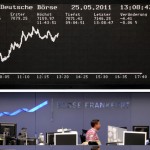 Friday’s trade saw EUR/USD within the range of 1.0809-1.0951. The pair closed at 1.0837, plummeting 0.93% on a daily basis. It has been the 11th drop in the past 20 trading days and also the sharpest one since November 6th, when the pair fell 1.30%. The daily low has been the lowest level since January 25th, when a low of 1.0786 was registered. In weekly terms, EUR/USD added 0.37% last week to mark its first gain in the past three weeks. The pair lost 0.32% of its value during January, marking its fourth drop in the past five months.
Friday’s trade saw EUR/USD within the range of 1.0809-1.0951. The pair closed at 1.0837, plummeting 0.93% on a daily basis. It has been the 11th drop in the past 20 trading days and also the sharpest one since November 6th, when the pair fell 1.30%. The daily low has been the lowest level since January 25th, when a low of 1.0786 was registered. In weekly terms, EUR/USD added 0.37% last week to mark its first gain in the past three weeks. The pair lost 0.32% of its value during January, marking its fourth drop in the past five months.
At 7:22 GMT today EUR/USD was gaining 0.24% for the day to trade at 1.0852. The pair touched a daily high at 1.0857 at 7:19 GMT, overshooting the daily R1 level, and a daily low at 1.0815 during the early phase of the Asian trading session.
On Monday EUR/USD trading may be influenced by the following macroeconomic reports as listed below.
Fundamentals
Euro area
Manufacturing PMI
Activity in Italys sector of manufacturing probably increased at a slower pace in January, with the corresponding Purchasing Managers Index (PMI) tumbling to a reading of 54.9, as expected by experts, from 55.6 in December. The latter has been the highest index value on record. Markit Economics is expected to release the official data at 8:45 GMT.
Frances final manufacturing PMI probably stood in the zone of expansion for a fifth consecutive month in January, while confirming the preliminary PMI reading of 50.0, which was reported on January 22nd. In December the final PMI was reported at 51.4, down from a preliminary 51.6. The official PMI is due out at 8:50 GMT.
The final reading of the German manufacturing PMI probably confirmed the preliminary value for January, with the index coming in at 52.1. If so, it would be the 14th consecutive month of expansion in activity. In December the final PMI stood at 53.2, improving from a preliminary value of 53.0. Markit will release the official reading at 8:55 GMT.
The final manufacturing PMI in the Euro zone probably also confirmed the preliminary value in January, with the index remaining at 52.3. If so, it would be the 31st consecutive month, during which the PMI inhabited the area above 50.0. In December the gauge stood at a final 53.2, up from a preliminary reading of 53.1. The PMI reflects the performance of the manufacturing sector in the Euro area and is based on a survey of 3 000 manufacturing companies. National data are included for Germany, France, Italy, Spain, the Netherlands, Austria, the Republic of Ireland and Greece. These member states together account for almost 90% of Euro zones manufacturing activity. The Manufacturing Purchasing Managers Index is comprised by five individual indexes with the following weights: New Orders (30%), Output (25%), Employment (20%), Suppliers’ Delivery Times (15%) and Stock of Items Purchased (10%), as the Delivery Times index is inverted, so that it moves in a comparable direction.
In case the final PMI readings exceeded expectations, this would have a moderate-to-strong bullish effect on the common currency. The official manufacturing PMI for the Euro region as a whole is scheduled to be released at 9:00 GMT.
United States
Personal Spending, Personal Income
Personal spending in the United States probably rose for an 8th straight month in December, up 0.1%, according to market expectations, while personal income was probably up for a 9th consecutive month in December, increasing at a monthly rate of 0.2%. Consumer spending, which accounts for over two thirds of the nations GDP, rose 0.3% in December, or at the fastest rate since August 2015.
At the same time, personal income increased 0.3% during the same month, while disposable personal income (DPI) rose USD 34.5 billion (or 0.3% as well). Private wages and salaries were up by USD 34.4 billion in November, compared to an increase by USD 45.7 billion in the prior month. Government wages and salaries were USD 2.8 billion higher in November, compared to an increase by USD 1.5 billion in October.
Higher-than-expected rates of increase imply good employment conditions and, therefore, are dollar positive. The Bureau of Economic Analysis is to publish the official figures at 13:30 GMT.
Manufacturing PMI by Markit – final reading
The final estimate of the Manufacturing Purchasing Managers Index for January probably confirmed the flash estimate of 52.7, which was reported on January 22nd. In December the final seasonally adjusted PMI stood at 51.2, inching down from a preliminary value of 51.3.
According to the preliminary report by Markit, ”…the pace of expansion was comfortably above the 26-month low recorded in December. Survey respondents mainly commented on higher output levels in response to positive new business trends and expectations of improving domestic demand over the months ahead.”
”Volumes of new work strengthened in January, after coming close to stagnation at the end of 2015. The latest increase in new orders was the fastest for three months. However, new export sales continued to rise at only a marginal pace, which manufacturers generally linked to the strong dollar. Companies that reported an overall upturn in new work mostly cited improving domestic economic conditions. The main exception to the wider trend was among manufacturers facing cutbacks in new orders from clients in the oil and gas sector”, Markit stated.
Values above the key level of 50.0 indicate optimism (expanding activity). In case the final PMI for January confirmed or came above the preliminary reading, this would cause a moderate bullish impact on the US dollar. The final reading is due out at 14:45 GMT.
Manufacturing PMI by the ISM
Activity in United States’ manufacturing sector probably improved in January, with the corresponding manufacturing PMI coming in at a reading of 48.5, according to expectations, up from 48.2 in December. The latter has been the lowest PMI reading since June 2009, when the gauge was reported at 44.8.
The New Orders Index came in at 49.2 in December, up from 48.9 in November. The sub-gauge of production was reported at 49.8, advancing from 49.2 in November. The index of employment slid to a value of 48.1 in December from 51.3 in the preceding month. The gauge of prices was at 33.5 in December, down from 35.5 in November, which suggested lower prices of raw materials for a 14th month in a row. In December, 6 manufacturing industries reported growth, 10 reported contraction and 2 registered no change in conditions, according to the report by the Institute for Supply Management (ISM).
In case the manufacturing PMI improved more than anticipated in January, this would have a moderate-to-strong bullish effect on the US dollar. The ISM is to release the official index reading at 15:00 GMT.
Daily and Weekly Pivot Levels
By employing the Camarilla calculation method, the daily pivot levels for EUR/USD are presented as follows:
R1 – 1.0850
R2 – 1.0863
R3 (range resistance) – 1.0876
R4 (range breakout) – 1.0915
S1 – 1.0824
S2 – 1.0811
S3 (range support) – 1.0798
S4 (range breakout) – 1.0759
By using the traditional method of calculation, the weekly pivot levels for EUR/USD are presented as follows:
Central Pivot Point – 1.0864
R1 – 1.0943
R2 – 1.1048
R3 – 1.1127
S1 – 1.0759
S2 – 1.0680
S3 – 1.0575





